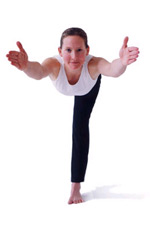
Exercise Videos
Exercise videos Home
Aerobics & Workout
Aquatics
Baby Boomer Fitness
Budokon
Dance to Fitness
Fitness Tools & Accessories
Jump Roping
Karate
Kick Boxing Exercise
Kids Dance & Exercise (& Sports!)
Pilates Mat Work
Prenatal Exercise
Recovery/Limited Mobility
Seniors' Dance & Exercise
Spinning
Stability/Fitness Ball
Workouts
Step Aerobics
Stretching & Warm up
Tai Chi/Qigong
Tone & Firm
Treadmill
Walking
Weight Training
Yoga
Instructors/Series
Denise Austin
The Firm
Cathe Friedrich
Gilad
Patrick Goudeau
Christy Lane
Lotte Berk Method
The Method
Leslie Sansone
Richard Simmons
Tae Bo
Urban Rebounding
System
Tai Chi Qigong
Variations of T'ai Chi Ch'uan's basic training forms are well known as the slow motion routines that groups of people practice every morning in hundreds of parks across China and other parts of the world. Traditional T'ai Chi training is intended to teach awareness of one's own balance and what affects it, awareness of the same in others, an appreciation of the practical value in one's ability to moderate extremes of behavior and attitude at both mental and physical levels, and how this applies to effective self-defense principles.
Qigong is an increasingly popular aspect of Chinese medicine involving the coordination of different breathing patterns with various physical postures and motions of the body. Qigong is mostly taught for health maintenance purposes, but there are also some who teach it, especially in China, for therapeutic interventions. Various forms of traditional qigong are also widely taught in conjunction with Chinese martial arts, and are especially prevalent in the advanced training of what are known as the nei chia (internal martial arts).
There are currently more than thirty three hundred different styles and schools of qigong. Qigong relies on the traditional Chinese belief that the body has an energy field generated and maintained by the natural respiration of the body, known as Qi. Qi means breath or to breathe in Mandarin Chinese, and by extension the energy produced by breathing that keeps us alive; gong means work or technique. Qigong is then "breath work" or the art of managing the breath to achieve and maintain good health, and especially in the martial arts, to enhance the leverage and stamina of the body in coordination with the physical process of respiration.
Attitudes toward the basis of qigong vary markedly. Most Western medical practitioners, many practitioners of traditional Chinese medicine, as well as the Chinese government view qigong as a set of breathing and movement exercises, with many possible benefits to health through stress reduction and exercise. Others see qigong in more metaphysical terms, claiming that breathing and movement exercises can influence the fundamental forces of the universe. An extreme form of the latter view was advocated by some participants in the Boxer Rebellion of the late 19th century who believed that breathing and movement exercises would allow them to ward off bullets.
